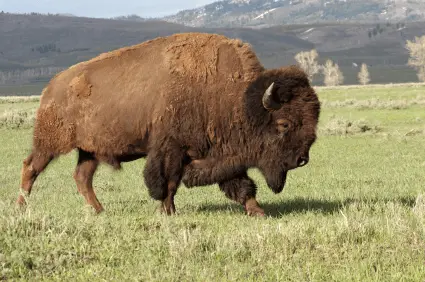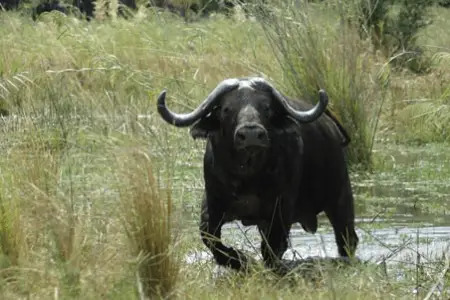The first American settlers named the American bison a buffalo thinking it was identical to the buffaloes they encountered in Africa and Asia. The misnomer remains uncorrected to this day despite the fact that these are two completely different animals. Their meats are often used interchangeably, particularly in restaurants and supermarkets.
Summary Table
| Bison Meat | Buffalo Meat |
| Comes from the American bison | Comes from the water buffaloes of Asia and Africa |
| Meat darker than beef with yellow to milky-white fat | Meat darker than beef with white fat |
| 100 grams (lean only) contains 109 calories, 1.84 grams fat and 21.62 grams of protein | 100 grams has 99 calories, 1.4 grams of fat and 20.4 grams of protein |
Descriptions

Bison meat is considered healthier than cattle meat because it has less fat and calorie content. Regardless, it has a fuller and sweeter taste compared to other meats. It has been found that bison meat is 91% fat-free. The bison is also rich in protein and low in cholesterol. The National Bison Association claims that 3.5 ounces of cooked bison meat contains 143 calories and just 2.5 grams of fat. Bison meat is also said to be a healthy source of omega-3 fatty acids.
Bison meat is lean and thus it cooks quickly and becomes tough when overcooked. This is why chefs usually recommend cooking bison steaks medium-done. Moisture can be kept in by searing the meat with a small amount of vegetable oil on high heat and then letting it cook slowly on low heat.

Buffalo meat is from a large bovid called a water buffalo. It is an animal raised for its meat and milk in places like Nepal, India, Bangladesh, Pakistan, Russia, Italy, Czechoslovakia, Bulgaria, and Egypt. Buffalo meat is also known as carabeef in Thailand, the Philippines, and other Southeast Asian countries. Meat from buffaloes less than 20 months old is called padwa in Pakistan and India, or pado in Nepal. Buffalo calves are fed only milk with the sole purpose of making their meat taste better for consumers. Their meat gets mistaken for beef (sometimes on purpose) in some places. Buffalo meat is dark colored with milky-white colored fat.
Buffalo meat tastes similar to beef, but is claimed to be a healthier alternative. It has lower fat and cholesterol than beef. In addition, water buffalo meat is known to contain high levels of the omega-3 fatty acids usually found in plant and marine oils.
Bison vs Buffalo Meat
So what’s the difference between bison and buffalo meat? A buffalo refers to the water buffalo found in many countries such as Nepal, India, Philippines, Bangladesh, Italy, and Russia. The word “bison” refers to the American bison (mistakenly called a buffalo) found in North America.
Studies suggest that buffalo meat is very low in fat and has the lowest cholesterol of all domesticated meat. In fact, 100 grams of uncooked buffalo meat has 99 calories, 1.4 grams of fat and 20.4 grams of protein. A 100-gram serving of bison meat (lean only) contains 109 calories, 1.84 grams fat and 21.62 grams of protein.
Water buffalo meat and bison meat have a dark color. Buffalo meat has white fat, while bison meat has yellow to milky-white colored fat.
Do Bison and Buffalo Meat Offer Any Health Benefits?
Yes! Both Bison and buffalo meat have many health benefits, including the following:
Lean protein: both meats are considered to be lean protein. They support healthy muscle development and maintenance.
Low fat: bison and buffalo meat contain the nutrients we need to be healthy, including iron, B vitamins, zinc, selenium, etc. These nutrients work to ensure bodily functions are running properly, including the immune system, production of energy, and cell growth.
Omega-3 fatty acids: buffalo and bison meat are also rich sources of omega-3 fatty acids. These are necessary for heart health and work to reduce inflammation in the body.
How are Buffalo and Bison Meat Used in Cooking?
The meat from buffalo and bison can be used in many different ways.
Grilling & roasting: both types of meat are great for grilling and roasting. These meats are lean, which helps them cook quickly while staying juicy.
Stir-fry & saute: buffalo and bison meats are also the perfect choice for stir-frying and saueteing. The meat from either bovine is cut into thin strips and tossed with various vegetables and sauces. The result is a fast, healthy, yummy meal!
Ground meat: ground buffalo and bison are also popular for use in a wide range of other recipes that call for ground meat. It’s possible to make meatballs, meatloaf, hamburgers, and more with these meats.
Braising & slow cooking: bison and buffalo meats are also great choices for slow cooking and braising. The longer cooking time helps the meat become more tender, with a deep rich flavor.





